A Comprehensive Analysis of the Duties and Responsibilities of Nurses
VerifiedAdded on 2023/04/23
|11
|2993
|181
Essay
AI Summary
This essay provides a comprehensive overview of the nursing profession, emphasizing the critical duties and responsibilities of nurses in various healthcare settings. It defines nursing as both a science and an art, highlighting the importance of empathy, knowledge, and continuous learning. The essay discusses the diverse roles within nursing, including Licensed Practical Nurses (LPNs) and Registered Nurses (RNs), and their respective educational requirements and responsibilities. It elaborates on the accountability of nurses, emphasizing their role in making informed decisions, ensuring patient satisfaction, and maintaining ethical standards. Furthermore, the essay covers essential aspects of patient care, such as monitoring vital signs, administering medications, and maintaining a safe environment. It also delves into the significance of blood pressure as a vital sign, discussing normal physiology, hypertension, and relevant parameters for assessment and management.
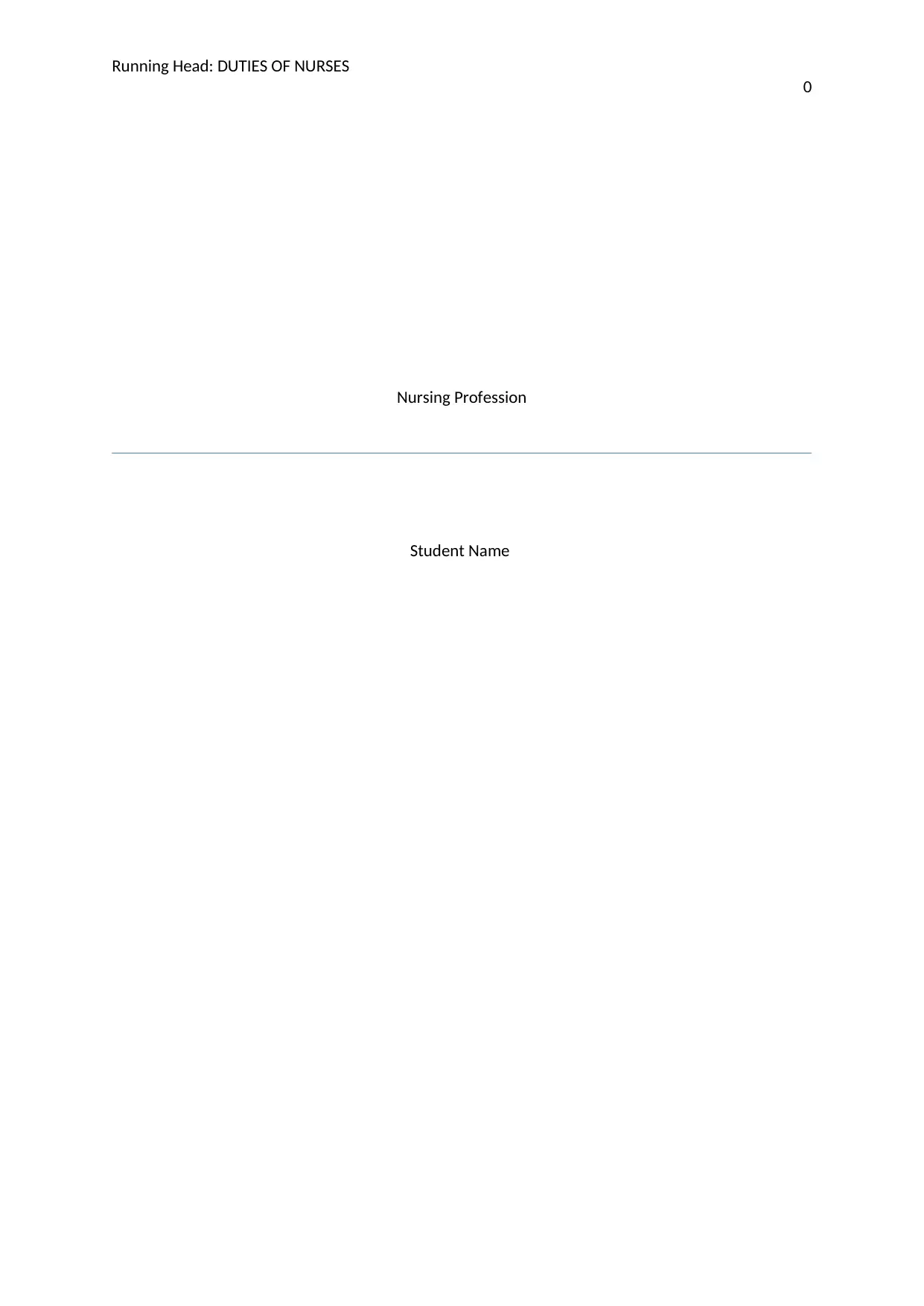
Running Head: DUTIES OF NURSES
0
Nursing Profession
Student Name
0
Nursing Profession
Student Name
Paraphrase This Document
Need a fresh take? Get an instant paraphrase of this document with our AI Paraphraser
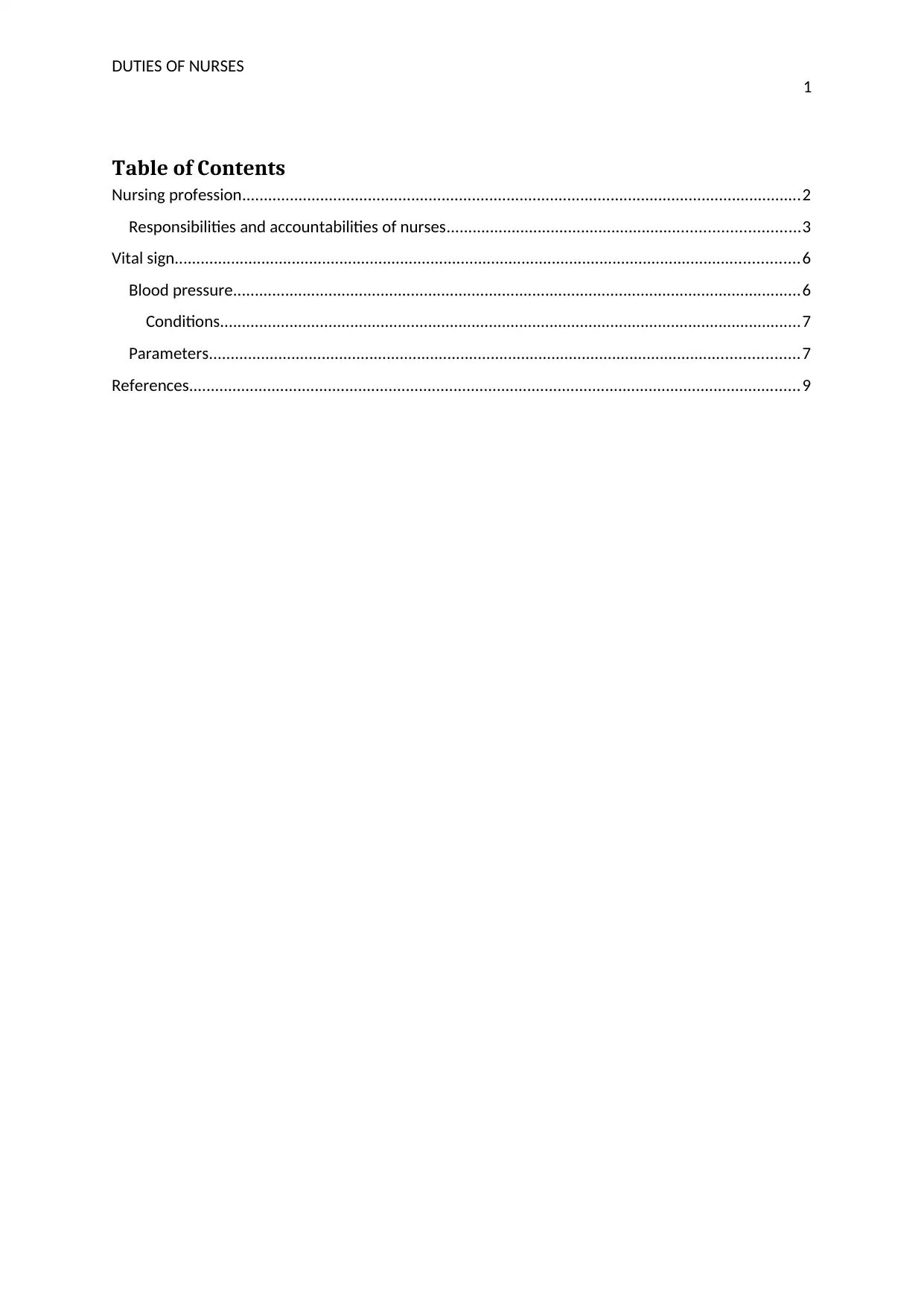
DUTIES OF NURSES
1
Table of Contents
Nursing profession.................................................................................................................................2
Responsibilities and accountabilities of nurses.................................................................................3
Vital sign................................................................................................................................................6
Blood pressure...................................................................................................................................6
Conditions......................................................................................................................................7
Parameters........................................................................................................................................7
References.............................................................................................................................................9
1
Table of Contents
Nursing profession.................................................................................................................................2
Responsibilities and accountabilities of nurses.................................................................................3
Vital sign................................................................................................................................................6
Blood pressure...................................................................................................................................6
Conditions......................................................................................................................................7
Parameters........................................................................................................................................7
References.............................................................................................................................................9
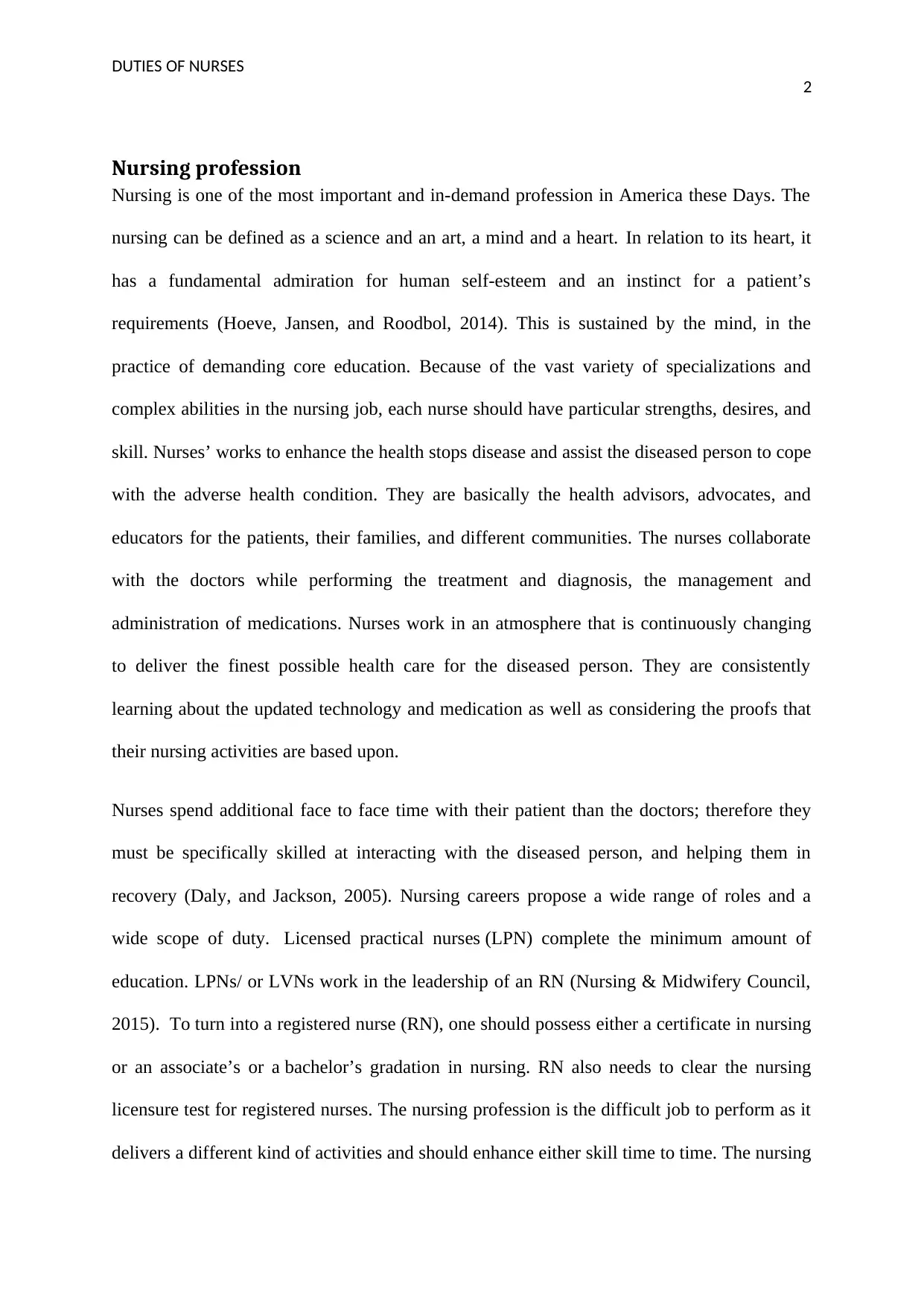
DUTIES OF NURSES
2
Nursing profession
Nursing is one of the most important and in-demand profession in America these Days. The
nursing can be defined as a science and an art, a mind and a heart. In relation to its heart, it
has a fundamental admiration for human self-esteem and an instinct for a patient’s
requirements (Hoeve, Jansen, and Roodbol, 2014). This is sustained by the mind, in the
practice of demanding core education. Because of the vast variety of specializations and
complex abilities in the nursing job, each nurse should have particular strengths, desires, and
skill. Nurses’ works to enhance the health stops disease and assist the diseased person to cope
with the adverse health condition. They are basically the health advisors, advocates, and
educators for the patients, their families, and different communities. The nurses collaborate
with the doctors while performing the treatment and diagnosis, the management and
administration of medications. Nurses work in an atmosphere that is continuously changing
to deliver the finest possible health care for the diseased person. They are consistently
learning about the updated technology and medication as well as considering the proofs that
their nursing activities are based upon.
Nurses spend additional face to face time with their patient than the doctors; therefore they
must be specifically skilled at interacting with the diseased person, and helping them in
recovery (Daly, and Jackson, 2005). Nursing careers propose a wide range of roles and a
wide scope of duty. Licensed practical nurses (LPN) complete the minimum amount of
education. LPNs/ or LVNs work in the leadership of an RN (Nursing & Midwifery Council,
2015). To turn into a registered nurse (RN), one should possess either a certificate in nursing
or an associate’s or a bachelor’s gradation in nursing. RN also needs to clear the nursing
licensure test for registered nurses. The nursing profession is the difficult job to perform as it
delivers a different kind of activities and should enhance either skill time to time. The nursing
2
Nursing profession
Nursing is one of the most important and in-demand profession in America these Days. The
nursing can be defined as a science and an art, a mind and a heart. In relation to its heart, it
has a fundamental admiration for human self-esteem and an instinct for a patient’s
requirements (Hoeve, Jansen, and Roodbol, 2014). This is sustained by the mind, in the
practice of demanding core education. Because of the vast variety of specializations and
complex abilities in the nursing job, each nurse should have particular strengths, desires, and
skill. Nurses’ works to enhance the health stops disease and assist the diseased person to cope
with the adverse health condition. They are basically the health advisors, advocates, and
educators for the patients, their families, and different communities. The nurses collaborate
with the doctors while performing the treatment and diagnosis, the management and
administration of medications. Nurses work in an atmosphere that is continuously changing
to deliver the finest possible health care for the diseased person. They are consistently
learning about the updated technology and medication as well as considering the proofs that
their nursing activities are based upon.
Nurses spend additional face to face time with their patient than the doctors; therefore they
must be specifically skilled at interacting with the diseased person, and helping them in
recovery (Daly, and Jackson, 2005). Nursing careers propose a wide range of roles and a
wide scope of duty. Licensed practical nurses (LPN) complete the minimum amount of
education. LPNs/ or LVNs work in the leadership of an RN (Nursing & Midwifery Council,
2015). To turn into a registered nurse (RN), one should possess either a certificate in nursing
or an associate’s or a bachelor’s gradation in nursing. RN also needs to clear the nursing
licensure test for registered nurses. The nursing profession is the difficult job to perform as it
delivers a different kind of activities and should enhance either skill time to time. The nursing
⊘ This is a preview!⊘
Do you want full access?
Subscribe today to unlock all pages.

Trusted by 1+ million students worldwide
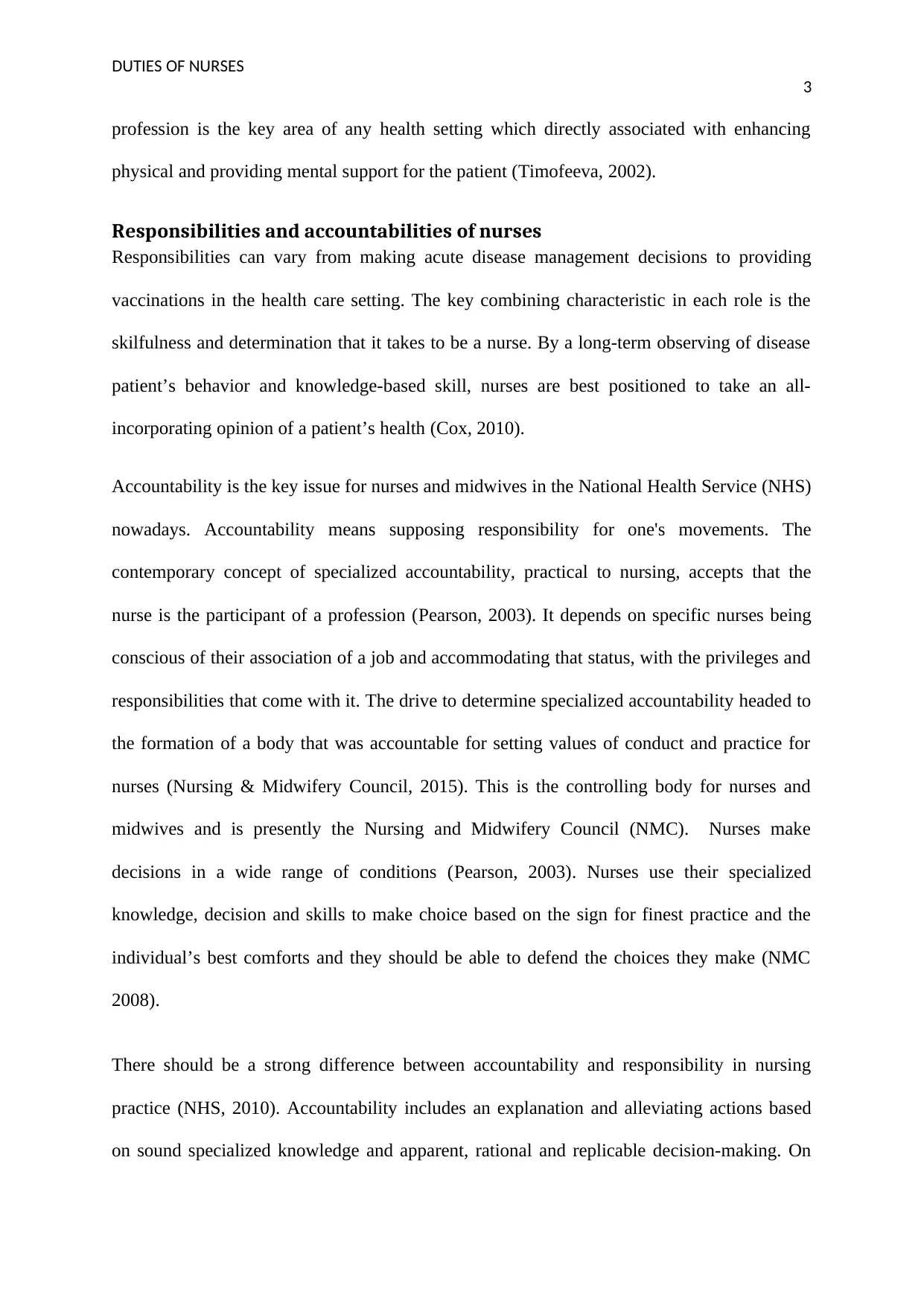
DUTIES OF NURSES
3
profession is the key area of any health setting which directly associated with enhancing
physical and providing mental support for the patient (Timofeeva, 2002).
Responsibilities and accountabilities of nurses
Responsibilities can vary from making acute disease management decisions to providing
vaccinations in the health care setting. The key combining characteristic in each role is the
skilfulness and determination that it takes to be a nurse. By a long-term observing of disease
patient’s behavior and knowledge-based skill, nurses are best positioned to take an all-
incorporating opinion of a patient’s health (Cox, 2010).
Accountability is the key issue for nurses and midwives in the National Health Service (NHS)
nowadays. Accountability means supposing responsibility for one's movements. The
contemporary concept of specialized accountability, practical to nursing, accepts that the
nurse is the participant of a profession (Pearson, 2003). It depends on specific nurses being
conscious of their association of a job and accommodating that status, with the privileges and
responsibilities that come with it. The drive to determine specialized accountability headed to
the formation of a body that was accountable for setting values of conduct and practice for
nurses (Nursing & Midwifery Council, 2015). This is the controlling body for nurses and
midwives and is presently the Nursing and Midwifery Council (NMC). Nurses make
decisions in a wide range of conditions (Pearson, 2003). Nurses use their specialized
knowledge, decision and skills to make choice based on the sign for finest practice and the
individual’s best comforts and they should be able to defend the choices they make (NMC
2008).
There should be a strong difference between accountability and responsibility in nursing
practice (NHS, 2010). Accountability includes an explanation and alleviating actions based
on sound specialized knowledge and apparent, rational and replicable decision-making. On
3
profession is the key area of any health setting which directly associated with enhancing
physical and providing mental support for the patient (Timofeeva, 2002).
Responsibilities and accountabilities of nurses
Responsibilities can vary from making acute disease management decisions to providing
vaccinations in the health care setting. The key combining characteristic in each role is the
skilfulness and determination that it takes to be a nurse. By a long-term observing of disease
patient’s behavior and knowledge-based skill, nurses are best positioned to take an all-
incorporating opinion of a patient’s health (Cox, 2010).
Accountability is the key issue for nurses and midwives in the National Health Service (NHS)
nowadays. Accountability means supposing responsibility for one's movements. The
contemporary concept of specialized accountability, practical to nursing, accepts that the
nurse is the participant of a profession (Pearson, 2003). It depends on specific nurses being
conscious of their association of a job and accommodating that status, with the privileges and
responsibilities that come with it. The drive to determine specialized accountability headed to
the formation of a body that was accountable for setting values of conduct and practice for
nurses (Nursing & Midwifery Council, 2015). This is the controlling body for nurses and
midwives and is presently the Nursing and Midwifery Council (NMC). Nurses make
decisions in a wide range of conditions (Pearson, 2003). Nurses use their specialized
knowledge, decision and skills to make choice based on the sign for finest practice and the
individual’s best comforts and they should be able to defend the choices they make (NMC
2008).
There should be a strong difference between accountability and responsibility in nursing
practice (NHS, 2010). Accountability includes an explanation and alleviating actions based
on sound specialized knowledge and apparent, rational and replicable decision-making. On
Paraphrase This Document
Need a fresh take? Get an instant paraphrase of this document with our AI Paraphraser
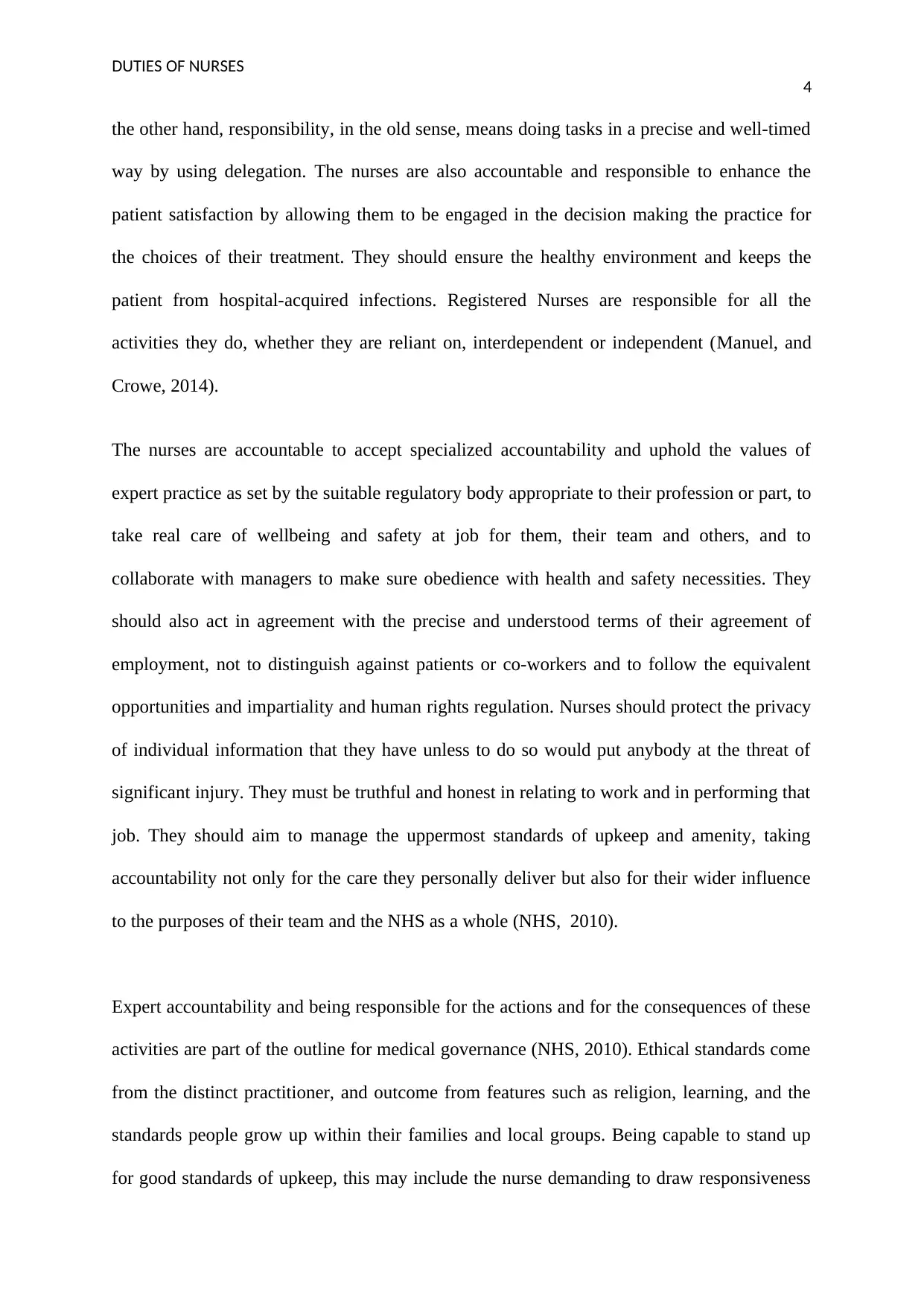
DUTIES OF NURSES
4
the other hand, responsibility, in the old sense, means doing tasks in a precise and well-timed
way by using delegation. The nurses are also accountable and responsible to enhance the
patient satisfaction by allowing them to be engaged in the decision making the practice for
the choices of their treatment. They should ensure the healthy environment and keeps the
patient from hospital-acquired infections. Registered Nurses are responsible for all the
activities they do, whether they are reliant on, interdependent or independent (Manuel, and
Crowe, 2014).
The nurses are accountable to accept specialized accountability and uphold the values of
expert practice as set by the suitable regulatory body appropriate to their profession or part, to
take real care of wellbeing and safety at job for them, their team and others, and to
collaborate with managers to make sure obedience with health and safety necessities. They
should also act in agreement with the precise and understood terms of their agreement of
employment, not to distinguish against patients or co-workers and to follow the equivalent
opportunities and impartiality and human rights regulation. Nurses should protect the privacy
of individual information that they have unless to do so would put anybody at the threat of
significant injury. They must be truthful and honest in relating to work and in performing that
job. They should aim to manage the uppermost standards of upkeep and amenity, taking
accountability not only for the care they personally deliver but also for their wider influence
to the purposes of their team and the NHS as a whole (NHS, 2010).
Expert accountability and being responsible for the actions and for the consequences of these
activities are part of the outline for medical governance (NHS, 2010). Ethical standards come
from the distinct practitioner, and outcome from features such as religion, learning, and the
standards people grow up within their families and local groups. Being capable to stand up
for good standards of upkeep, this may include the nurse demanding to draw responsiveness
4
the other hand, responsibility, in the old sense, means doing tasks in a precise and well-timed
way by using delegation. The nurses are also accountable and responsible to enhance the
patient satisfaction by allowing them to be engaged in the decision making the practice for
the choices of their treatment. They should ensure the healthy environment and keeps the
patient from hospital-acquired infections. Registered Nurses are responsible for all the
activities they do, whether they are reliant on, interdependent or independent (Manuel, and
Crowe, 2014).
The nurses are accountable to accept specialized accountability and uphold the values of
expert practice as set by the suitable regulatory body appropriate to their profession or part, to
take real care of wellbeing and safety at job for them, their team and others, and to
collaborate with managers to make sure obedience with health and safety necessities. They
should also act in agreement with the precise and understood terms of their agreement of
employment, not to distinguish against patients or co-workers and to follow the equivalent
opportunities and impartiality and human rights regulation. Nurses should protect the privacy
of individual information that they have unless to do so would put anybody at the threat of
significant injury. They must be truthful and honest in relating to work and in performing that
job. They should aim to manage the uppermost standards of upkeep and amenity, taking
accountability not only for the care they personally deliver but also for their wider influence
to the purposes of their team and the NHS as a whole (NHS, 2010).
Expert accountability and being responsible for the actions and for the consequences of these
activities are part of the outline for medical governance (NHS, 2010). Ethical standards come
from the distinct practitioner, and outcome from features such as religion, learning, and the
standards people grow up within their families and local groups. Being capable to stand up
for good standards of upkeep, this may include the nurse demanding to draw responsiveness
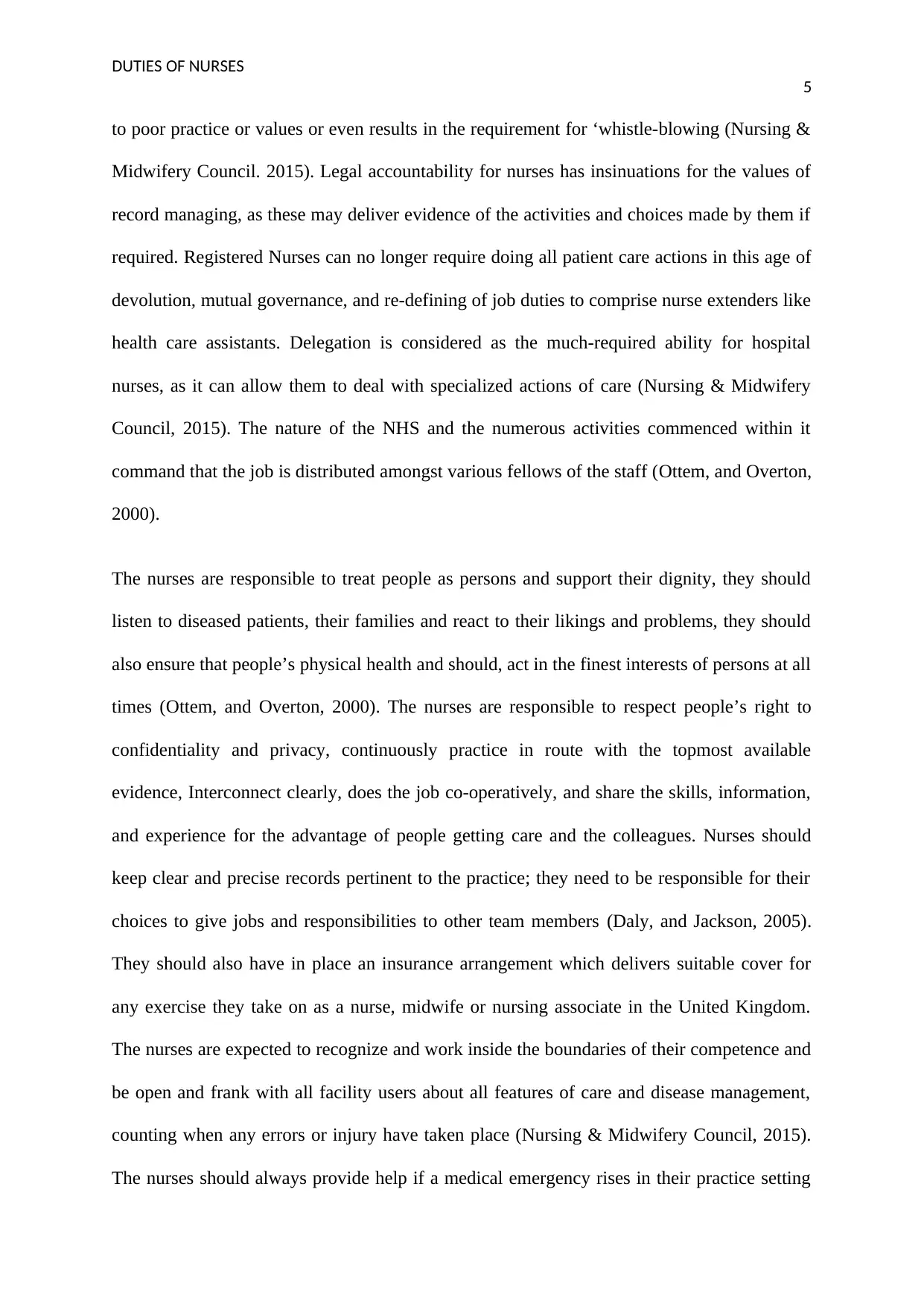
DUTIES OF NURSES
5
to poor practice or values or even results in the requirement for ‘whistle-blowing (Nursing &
Midwifery Council. 2015). Legal accountability for nurses has insinuations for the values of
record managing, as these may deliver evidence of the activities and choices made by them if
required. Registered Nurses can no longer require doing all patient care actions in this age of
devolution, mutual governance, and re-defining of job duties to comprise nurse extenders like
health care assistants. Delegation is considered as the much-required ability for hospital
nurses, as it can allow them to deal with specialized actions of care (Nursing & Midwifery
Council, 2015). The nature of the NHS and the numerous activities commenced within it
command that the job is distributed amongst various fellows of the staff (Ottem, and Overton,
2000).
The nurses are responsible to treat people as persons and support their dignity, they should
listen to diseased patients, their families and react to their likings and problems, they should
also ensure that people’s physical health and should, act in the finest interests of persons at all
times (Ottem, and Overton, 2000). The nurses are responsible to respect people’s right to
confidentiality and privacy, continuously practice in route with the topmost available
evidence, Interconnect clearly, does the job co-operatively, and share the skills, information,
and experience for the advantage of people getting care and the colleagues. Nurses should
keep clear and precise records pertinent to the practice; they need to be responsible for their
choices to give jobs and responsibilities to other team members (Daly, and Jackson, 2005).
They should also have in place an insurance arrangement which delivers suitable cover for
any exercise they take on as a nurse, midwife or nursing associate in the United Kingdom.
The nurses are expected to recognize and work inside the boundaries of their competence and
be open and frank with all facility users about all features of care and disease management,
counting when any errors or injury have taken place (Nursing & Midwifery Council, 2015).
The nurses should always provide help if a medical emergency rises in their practice setting
5
to poor practice or values or even results in the requirement for ‘whistle-blowing (Nursing &
Midwifery Council. 2015). Legal accountability for nurses has insinuations for the values of
record managing, as these may deliver evidence of the activities and choices made by them if
required. Registered Nurses can no longer require doing all patient care actions in this age of
devolution, mutual governance, and re-defining of job duties to comprise nurse extenders like
health care assistants. Delegation is considered as the much-required ability for hospital
nurses, as it can allow them to deal with specialized actions of care (Nursing & Midwifery
Council, 2015). The nature of the NHS and the numerous activities commenced within it
command that the job is distributed amongst various fellows of the staff (Ottem, and Overton,
2000).
The nurses are responsible to treat people as persons and support their dignity, they should
listen to diseased patients, their families and react to their likings and problems, they should
also ensure that people’s physical health and should, act in the finest interests of persons at all
times (Ottem, and Overton, 2000). The nurses are responsible to respect people’s right to
confidentiality and privacy, continuously practice in route with the topmost available
evidence, Interconnect clearly, does the job co-operatively, and share the skills, information,
and experience for the advantage of people getting care and the colleagues. Nurses should
keep clear and precise records pertinent to the practice; they need to be responsible for their
choices to give jobs and responsibilities to other team members (Daly, and Jackson, 2005).
They should also have in place an insurance arrangement which delivers suitable cover for
any exercise they take on as a nurse, midwife or nursing associate in the United Kingdom.
The nurses are expected to recognize and work inside the boundaries of their competence and
be open and frank with all facility users about all features of care and disease management,
counting when any errors or injury have taken place (Nursing & Midwifery Council, 2015).
The nurses should always provide help if a medical emergency rises in their practice setting
⊘ This is a preview!⊘
Do you want full access?
Subscribe today to unlock all pages.

Trusted by 1+ million students worldwide
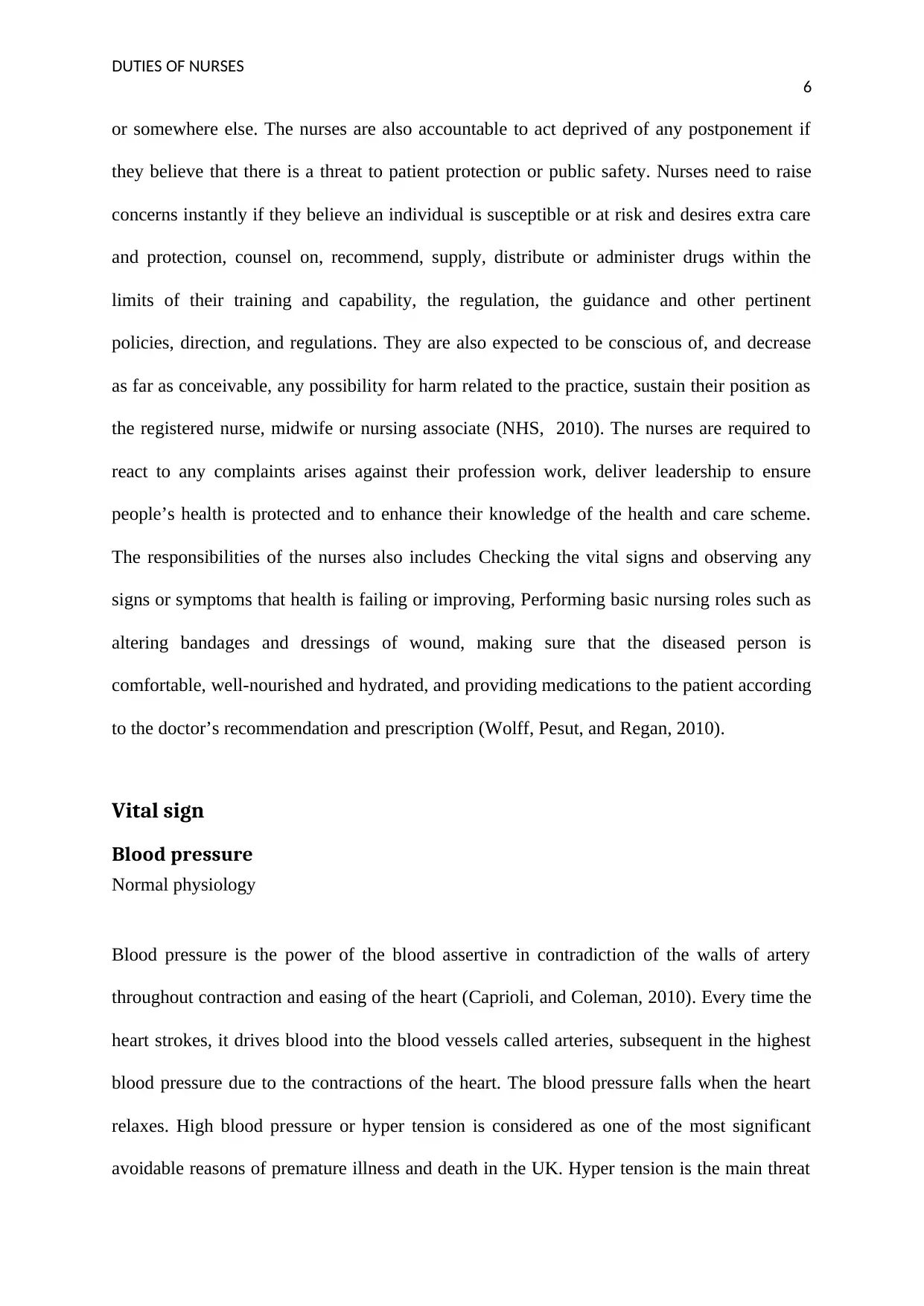
DUTIES OF NURSES
6
or somewhere else. The nurses are also accountable to act deprived of any postponement if
they believe that there is a threat to patient protection or public safety. Nurses need to raise
concerns instantly if they believe an individual is susceptible or at risk and desires extra care
and protection, counsel on, recommend, supply, distribute or administer drugs within the
limits of their training and capability, the regulation, the guidance and other pertinent
policies, direction, and regulations. They are also expected to be conscious of, and decrease
as far as conceivable, any possibility for harm related to the practice, sustain their position as
the registered nurse, midwife or nursing associate (NHS, 2010). The nurses are required to
react to any complaints arises against their profession work, deliver leadership to ensure
people’s health is protected and to enhance their knowledge of the health and care scheme.
The responsibilities of the nurses also includes Checking the vital signs and observing any
signs or symptoms that health is failing or improving, Performing basic nursing roles such as
altering bandages and dressings of wound, making sure that the diseased person is
comfortable, well-nourished and hydrated, and providing medications to the patient according
to the doctor’s recommendation and prescription (Wolff, Pesut, and Regan, 2010).
Vital sign
Blood pressure
Normal physiology
Blood pressure is the power of the blood assertive in contradiction of the walls of artery
throughout contraction and easing of the heart (Caprioli, and Coleman, 2010). Every time the
heart strokes, it drives blood into the blood vessels called arteries, subsequent in the highest
blood pressure due to the contractions of the heart. The blood pressure falls when the heart
relaxes. High blood pressure or hyper tension is considered as one of the most significant
avoidable reasons of premature illness and death in the UK. Hyper tension is the main threat
6
or somewhere else. The nurses are also accountable to act deprived of any postponement if
they believe that there is a threat to patient protection or public safety. Nurses need to raise
concerns instantly if they believe an individual is susceptible or at risk and desires extra care
and protection, counsel on, recommend, supply, distribute or administer drugs within the
limits of their training and capability, the regulation, the guidance and other pertinent
policies, direction, and regulations. They are also expected to be conscious of, and decrease
as far as conceivable, any possibility for harm related to the practice, sustain their position as
the registered nurse, midwife or nursing associate (NHS, 2010). The nurses are required to
react to any complaints arises against their profession work, deliver leadership to ensure
people’s health is protected and to enhance their knowledge of the health and care scheme.
The responsibilities of the nurses also includes Checking the vital signs and observing any
signs or symptoms that health is failing or improving, Performing basic nursing roles such as
altering bandages and dressings of wound, making sure that the diseased person is
comfortable, well-nourished and hydrated, and providing medications to the patient according
to the doctor’s recommendation and prescription (Wolff, Pesut, and Regan, 2010).
Vital sign
Blood pressure
Normal physiology
Blood pressure is the power of the blood assertive in contradiction of the walls of artery
throughout contraction and easing of the heart (Caprioli, and Coleman, 2010). Every time the
heart strokes, it drives blood into the blood vessels called arteries, subsequent in the highest
blood pressure due to the contractions of the heart. The blood pressure falls when the heart
relaxes. High blood pressure or hyper tension is considered as one of the most significant
avoidable reasons of premature illness and death in the UK. Hyper tension is the main threat
Paraphrase This Document
Need a fresh take? Get an instant paraphrase of this document with our AI Paraphraser
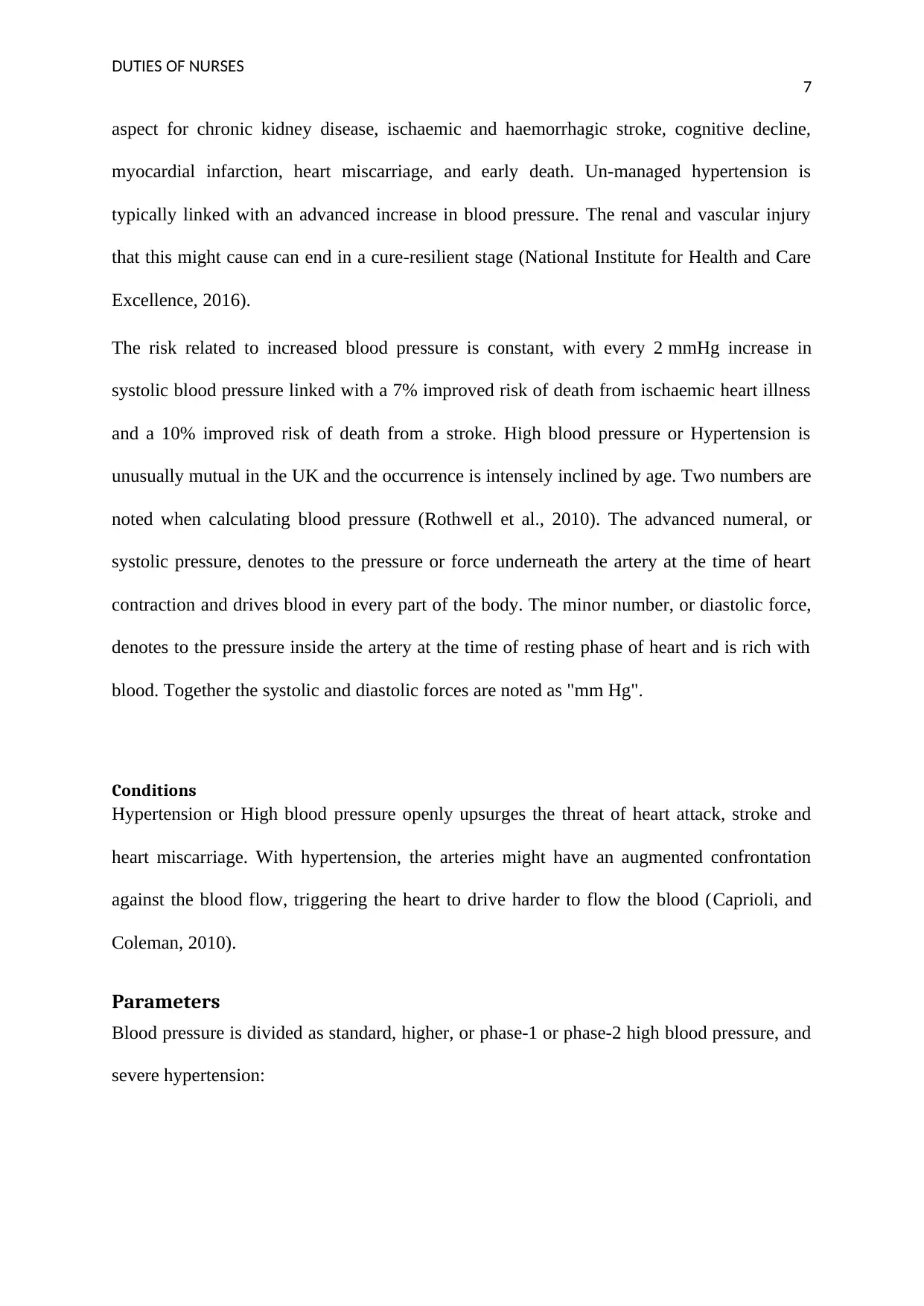
DUTIES OF NURSES
7
aspect for chronic kidney disease, ischaemic and haemorrhagic stroke, cognitive decline,
myocardial infarction, heart miscarriage, and early death. Un-managed hypertension is
typically linked with an advanced increase in blood pressure. The renal and vascular injury
that this might cause can end in a cure-resilient stage (National Institute for Health and Care
Excellence, 2016).
The risk related to increased blood pressure is constant, with every 2 mmHg increase in
systolic blood pressure linked with a 7% improved risk of death from ischaemic heart illness
and a 10% improved risk of death from a stroke. High blood pressure or Hypertension is
unusually mutual in the UK and the occurrence is intensely inclined by age. Two numbers are
noted when calculating blood pressure (Rothwell et al., 2010). The advanced numeral, or
systolic pressure, denotes to the pressure or force underneath the artery at the time of heart
contraction and drives blood in every part of the body. The minor number, or diastolic force,
denotes to the pressure inside the artery at the time of resting phase of heart and is rich with
blood. Together the systolic and diastolic forces are noted as "mm Hg".
Conditions
Hypertension or High blood pressure openly upsurges the threat of heart attack, stroke and
heart miscarriage. With hypertension, the arteries might have an augmented confrontation
against the blood flow, triggering the heart to drive harder to flow the blood (Caprioli, and
Coleman, 2010).
Parameters
Blood pressure is divided as standard, higher, or phase-1 or phase-2 high blood pressure, and
severe hypertension:
7
aspect for chronic kidney disease, ischaemic and haemorrhagic stroke, cognitive decline,
myocardial infarction, heart miscarriage, and early death. Un-managed hypertension is
typically linked with an advanced increase in blood pressure. The renal and vascular injury
that this might cause can end in a cure-resilient stage (National Institute for Health and Care
Excellence, 2016).
The risk related to increased blood pressure is constant, with every 2 mmHg increase in
systolic blood pressure linked with a 7% improved risk of death from ischaemic heart illness
and a 10% improved risk of death from a stroke. High blood pressure or Hypertension is
unusually mutual in the UK and the occurrence is intensely inclined by age. Two numbers are
noted when calculating blood pressure (Rothwell et al., 2010). The advanced numeral, or
systolic pressure, denotes to the pressure or force underneath the artery at the time of heart
contraction and drives blood in every part of the body. The minor number, or diastolic force,
denotes to the pressure inside the artery at the time of resting phase of heart and is rich with
blood. Together the systolic and diastolic forces are noted as "mm Hg".
Conditions
Hypertension or High blood pressure openly upsurges the threat of heart attack, stroke and
heart miscarriage. With hypertension, the arteries might have an augmented confrontation
against the blood flow, triggering the heart to drive harder to flow the blood (Caprioli, and
Coleman, 2010).
Parameters
Blood pressure is divided as standard, higher, or phase-1 or phase-2 high blood pressure, and
severe hypertension:
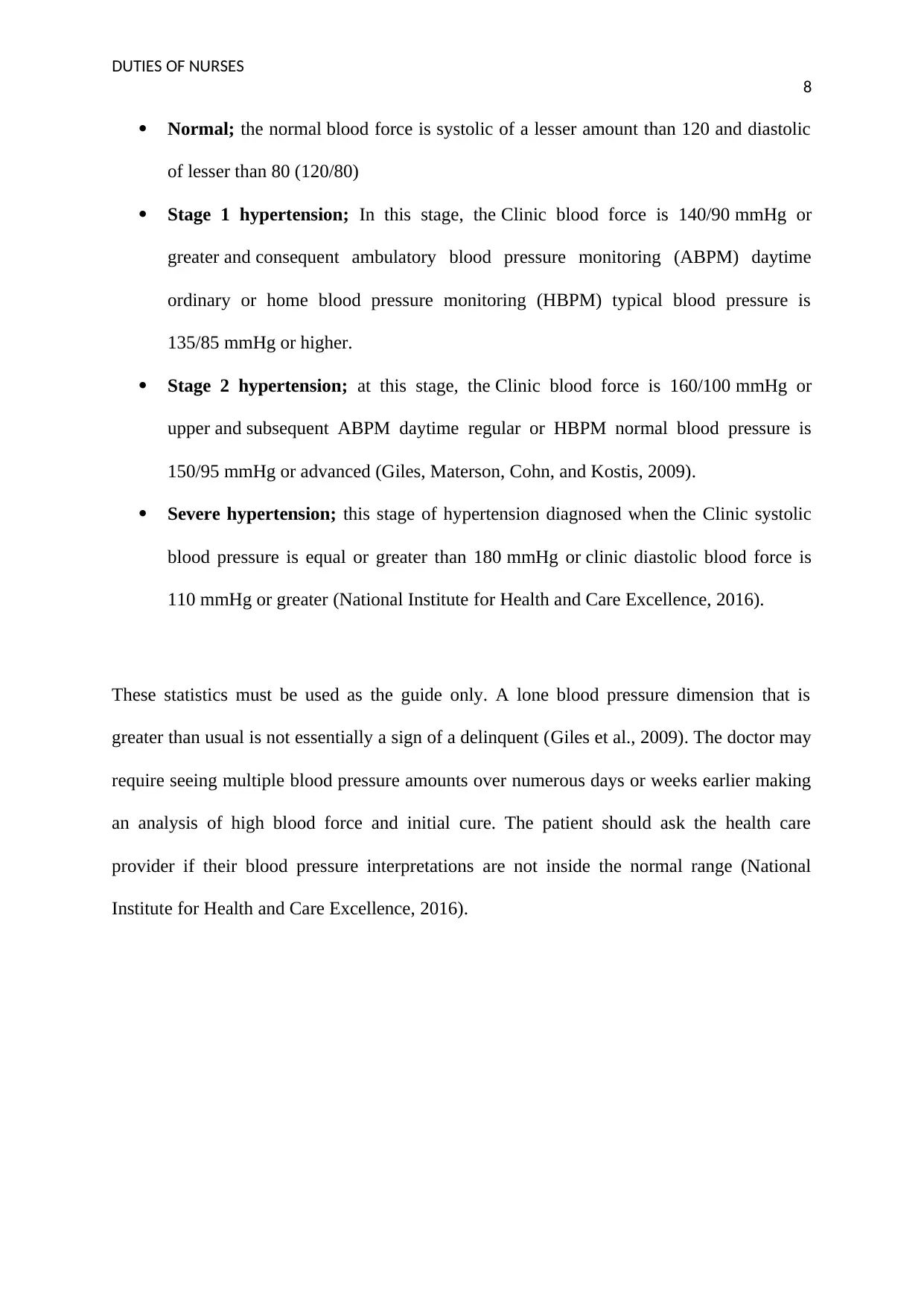
DUTIES OF NURSES
8
Normal; the normal blood force is systolic of a lesser amount than 120 and diastolic
of lesser than 80 (120/80)
Stage 1 hypertension; In this stage, the Clinic blood force is 140/90 mmHg or
greater and consequent ambulatory blood pressure monitoring (ABPM) daytime
ordinary or home blood pressure monitoring (HBPM) typical blood pressure is
135/85 mmHg or higher.
Stage 2 hypertension; at this stage, the Clinic blood force is 160/100 mmHg or
upper and subsequent ABPM daytime regular or HBPM normal blood pressure is
150/95 mmHg or advanced (Giles, Materson, Cohn, and Kostis, 2009).
Severe hypertension; this stage of hypertension diagnosed when the Clinic systolic
blood pressure is equal or greater than 180 mmHg or clinic diastolic blood force is
110 mmHg or greater (National Institute for Health and Care Excellence, 2016).
These statistics must be used as the guide only. A lone blood pressure dimension that is
greater than usual is not essentially a sign of a delinquent (Giles et al., 2009). The doctor may
require seeing multiple blood pressure amounts over numerous days or weeks earlier making
an analysis of high blood force and initial cure. The patient should ask the health care
provider if their blood pressure interpretations are not inside the normal range (National
Institute for Health and Care Excellence, 2016).
8
Normal; the normal blood force is systolic of a lesser amount than 120 and diastolic
of lesser than 80 (120/80)
Stage 1 hypertension; In this stage, the Clinic blood force is 140/90 mmHg or
greater and consequent ambulatory blood pressure monitoring (ABPM) daytime
ordinary or home blood pressure monitoring (HBPM) typical blood pressure is
135/85 mmHg or higher.
Stage 2 hypertension; at this stage, the Clinic blood force is 160/100 mmHg or
upper and subsequent ABPM daytime regular or HBPM normal blood pressure is
150/95 mmHg or advanced (Giles, Materson, Cohn, and Kostis, 2009).
Severe hypertension; this stage of hypertension diagnosed when the Clinic systolic
blood pressure is equal or greater than 180 mmHg or clinic diastolic blood force is
110 mmHg or greater (National Institute for Health and Care Excellence, 2016).
These statistics must be used as the guide only. A lone blood pressure dimension that is
greater than usual is not essentially a sign of a delinquent (Giles et al., 2009). The doctor may
require seeing multiple blood pressure amounts over numerous days or weeks earlier making
an analysis of high blood force and initial cure. The patient should ask the health care
provider if their blood pressure interpretations are not inside the normal range (National
Institute for Health and Care Excellence, 2016).
⊘ This is a preview!⊘
Do you want full access?
Subscribe today to unlock all pages.

Trusted by 1+ million students worldwide
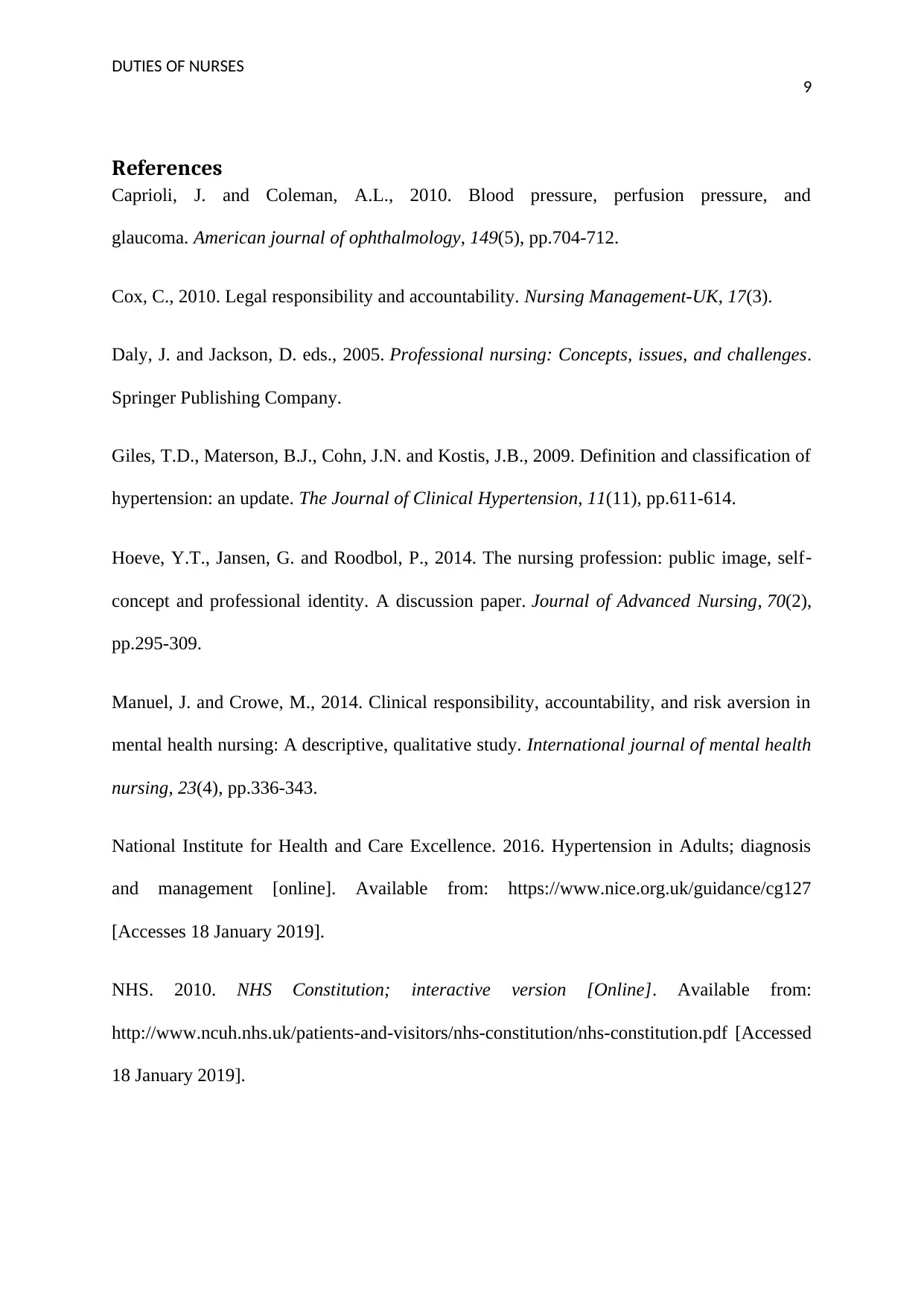
DUTIES OF NURSES
9
References
Caprioli, J. and Coleman, A.L., 2010. Blood pressure, perfusion pressure, and
glaucoma. American journal of ophthalmology, 149(5), pp.704-712.
Cox, C., 2010. Legal responsibility and accountability. Nursing Management-UK, 17(3).
Daly, J. and Jackson, D. eds., 2005. Professional nursing: Concepts, issues, and challenges.
Springer Publishing Company.
Giles, T.D., Materson, B.J., Cohn, J.N. and Kostis, J.B., 2009. Definition and classification of
hypertension: an update. The Journal of Clinical Hypertension, 11(11), pp.611-614.
Hoeve, Y.T., Jansen, G. and Roodbol, P., 2014. The nursing profession: public image, self‐
concept and professional identity. A discussion paper. Journal of Advanced Nursing, 70(2),
pp.295-309.
Manuel, J. and Crowe, M., 2014. Clinical responsibility, accountability, and risk aversion in
mental health nursing: A descriptive, qualitative study. International journal of mental health
nursing, 23(4), pp.336-343.
National Institute for Health and Care Excellence. 2016. Hypertension in Adults; diagnosis
and management [online]. Available from: https://www.nice.org.uk/guidance/cg127
[Accesses 18 January 2019].
NHS. 2010. NHS Constitution; interactive version [Online]. Available from:
http://www.ncuh.nhs.uk/patients-and-visitors/nhs-constitution/nhs-constitution.pdf [Accessed
18 January 2019].
9
References
Caprioli, J. and Coleman, A.L., 2010. Blood pressure, perfusion pressure, and
glaucoma. American journal of ophthalmology, 149(5), pp.704-712.
Cox, C., 2010. Legal responsibility and accountability. Nursing Management-UK, 17(3).
Daly, J. and Jackson, D. eds., 2005. Professional nursing: Concepts, issues, and challenges.
Springer Publishing Company.
Giles, T.D., Materson, B.J., Cohn, J.N. and Kostis, J.B., 2009. Definition and classification of
hypertension: an update. The Journal of Clinical Hypertension, 11(11), pp.611-614.
Hoeve, Y.T., Jansen, G. and Roodbol, P., 2014. The nursing profession: public image, self‐
concept and professional identity. A discussion paper. Journal of Advanced Nursing, 70(2),
pp.295-309.
Manuel, J. and Crowe, M., 2014. Clinical responsibility, accountability, and risk aversion in
mental health nursing: A descriptive, qualitative study. International journal of mental health
nursing, 23(4), pp.336-343.
National Institute for Health and Care Excellence. 2016. Hypertension in Adults; diagnosis
and management [online]. Available from: https://www.nice.org.uk/guidance/cg127
[Accesses 18 January 2019].
NHS. 2010. NHS Constitution; interactive version [Online]. Available from:
http://www.ncuh.nhs.uk/patients-and-visitors/nhs-constitution/nhs-constitution.pdf [Accessed
18 January 2019].
Paraphrase This Document
Need a fresh take? Get an instant paraphrase of this document with our AI Paraphraser
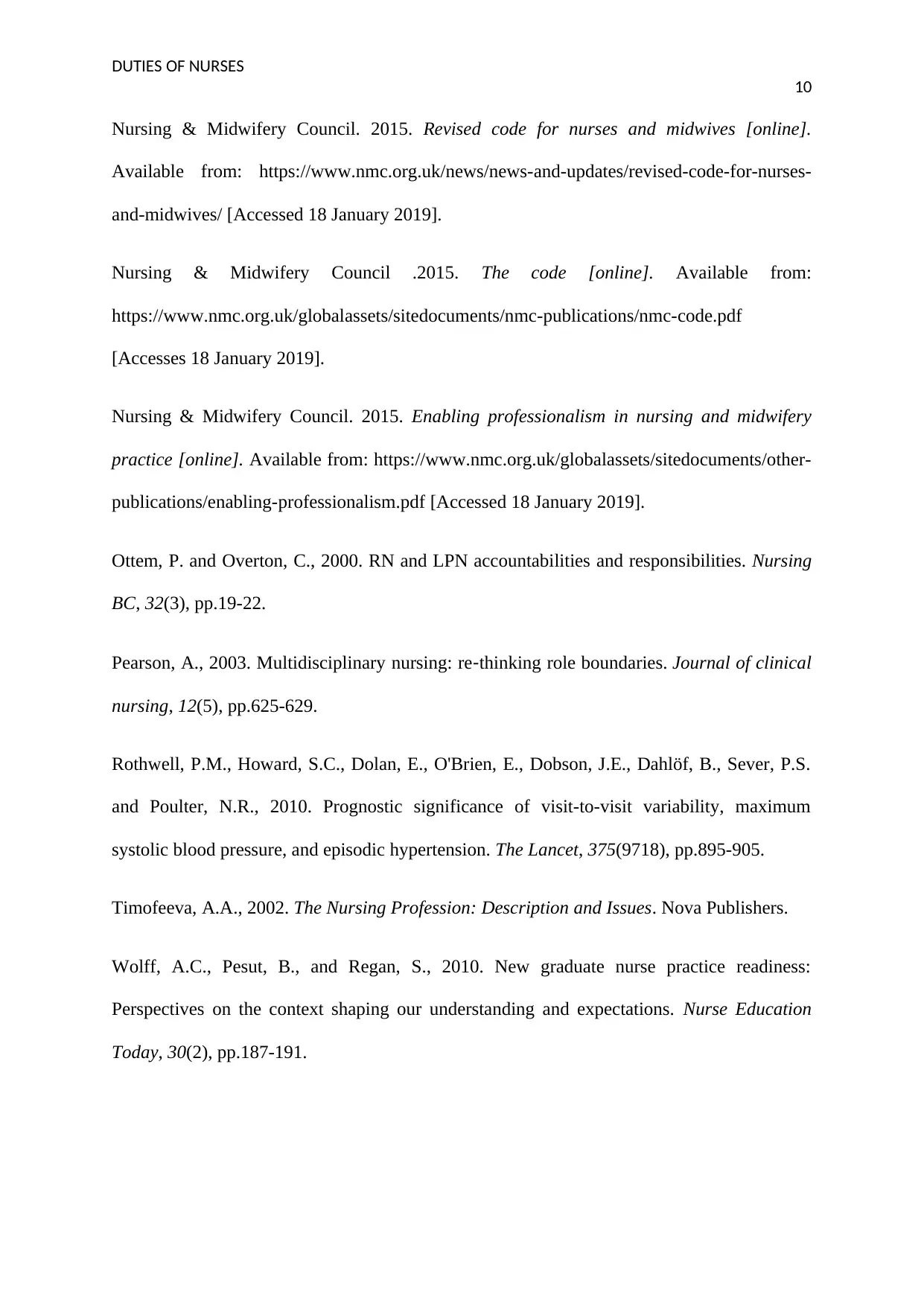
DUTIES OF NURSES
10
Nursing & Midwifery Council. 2015. Revised code for nurses and midwives [online].
Available from: https://www.nmc.org.uk/news/news-and-updates/revised-code-for-nurses-
and-midwives/ [Accessed 18 January 2019].
Nursing & Midwifery Council .2015. The code [online]. Available from:
https://www.nmc.org.uk/globalassets/sitedocuments/nmc-publications/nmc-code.pdf
[Accesses 18 January 2019].
Nursing & Midwifery Council. 2015. Enabling professionalism in nursing and midwifery
practice [online]. Available from: https://www.nmc.org.uk/globalassets/sitedocuments/other-
publications/enabling-professionalism.pdf [Accessed 18 January 2019].
Ottem, P. and Overton, C., 2000. RN and LPN accountabilities and responsibilities. Nursing
BC, 32(3), pp.19-22.
Pearson, A., 2003. Multidisciplinary nursing: re‐thinking role boundaries. Journal of clinical
nursing, 12(5), pp.625-629.
Rothwell, P.M., Howard, S.C., Dolan, E., O'Brien, E., Dobson, J.E., Dahlöf, B., Sever, P.S.
and Poulter, N.R., 2010. Prognostic significance of visit-to-visit variability, maximum
systolic blood pressure, and episodic hypertension. The Lancet, 375(9718), pp.895-905.
Timofeeva, A.A., 2002. The Nursing Profession: Description and Issues. Nova Publishers.
Wolff, A.C., Pesut, B., and Regan, S., 2010. New graduate nurse practice readiness:
Perspectives on the context shaping our understanding and expectations. Nurse Education
Today, 30(2), pp.187-191.
10
Nursing & Midwifery Council. 2015. Revised code for nurses and midwives [online].
Available from: https://www.nmc.org.uk/news/news-and-updates/revised-code-for-nurses-
and-midwives/ [Accessed 18 January 2019].
Nursing & Midwifery Council .2015. The code [online]. Available from:
https://www.nmc.org.uk/globalassets/sitedocuments/nmc-publications/nmc-code.pdf
[Accesses 18 January 2019].
Nursing & Midwifery Council. 2015. Enabling professionalism in nursing and midwifery
practice [online]. Available from: https://www.nmc.org.uk/globalassets/sitedocuments/other-
publications/enabling-professionalism.pdf [Accessed 18 January 2019].
Ottem, P. and Overton, C., 2000. RN and LPN accountabilities and responsibilities. Nursing
BC, 32(3), pp.19-22.
Pearson, A., 2003. Multidisciplinary nursing: re‐thinking role boundaries. Journal of clinical
nursing, 12(5), pp.625-629.
Rothwell, P.M., Howard, S.C., Dolan, E., O'Brien, E., Dobson, J.E., Dahlöf, B., Sever, P.S.
and Poulter, N.R., 2010. Prognostic significance of visit-to-visit variability, maximum
systolic blood pressure, and episodic hypertension. The Lancet, 375(9718), pp.895-905.
Timofeeva, A.A., 2002. The Nursing Profession: Description and Issues. Nova Publishers.
Wolff, A.C., Pesut, B., and Regan, S., 2010. New graduate nurse practice readiness:
Perspectives on the context shaping our understanding and expectations. Nurse Education
Today, 30(2), pp.187-191.
1 out of 11
Related Documents
Your All-in-One AI-Powered Toolkit for Academic Success.
+13062052269
info@desklib.com
Available 24*7 on WhatsApp / Email
![[object Object]](/_next/static/media/star-bottom.7253800d.svg)
Unlock your academic potential
Copyright © 2020–2025 A2Z Services. All Rights Reserved. Developed and managed by ZUCOL.




